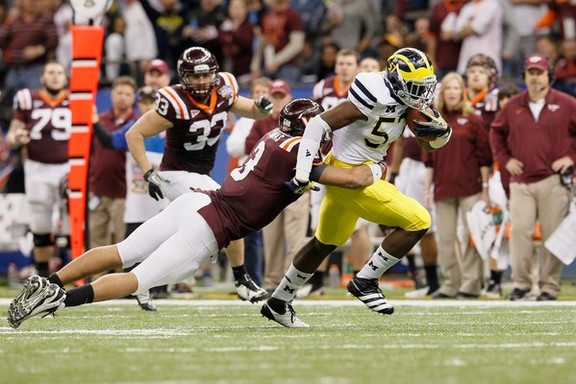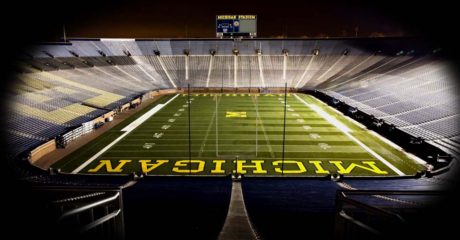Sugar Bowl: Michigan vs. Virginia Tech Grades – Defense
 |
| This interception was Frank Clark’s best play of the day, but not his only good one. |
Just like post-Nebraska and post-Ohio State, I reviewed the film of the Sugar Bowl and graded out the defense for good/bad reads, filling/missing assignments, and physical superiority/inferiority. Each time a player had a significant impact on a play, he was given a grade ranging from +3 to -3.
GRADES
FClark: +10 . . . Too quick for offensive line to handle; made a great interception
JRyan: +10 . . . Pursuit and hustle were stellar; took great angles
MMartin: +9 . . . Seemed to get tired in second half, but too fast off the snap most of the time
RVanBergen: +9 . . . No spectacular plays but just disruptive enough to force Wilson to hesitate
JKovacs: +7 . . . Good tackler but also wades through trash well
CRoh: +3 . . . Got reach blocked a couple times, but mostly filled his assignments
BBeyer: +1 . . . Limited playing time
KDemens: +1 . . . Missed several tackles, but made a nice PBU and filled his gap
QWashington: +1 . . . Limited playing time
JBlack: 0 . . . Looks too slow for weakside end
CAvery: -1 . . . Had trouble fighting off blocks early, but supported run well after first quarter
WCampbell: -2 . . . Got reach blocked too easily; too passive mostly, but had a couple “wow” moments
TGordon: -2 . . . Had a rough first half but got better as the game went along
BCountess: -3 . . . Picked on especially in zone coverage, but fared better in man
DMorgan: -4 . . . Not bad for a freshman linebacker but looked like a freshman linebacker
JFloyd: -5 . . . Okay in pass coverage, poor against the run
CONCLUSIONS
The usual suspects were stellar for the most part, but sitting atop the list is a bit of a surprise: freshman defensive end Frank Clark. Aside from the highlight-reel interception, Clark consistently beat Virginia Tech’s left tackle with slants and speed rushes. Of course, part of the credit for Clark’s +10 goes to Greg Mattison, who used Clark to stunt more often than he did with Roh. Hooray for using players’ strengths!
Redshirt freshman SAM linebacker Jake Ryan was also outstanding, receiving only one negative mark (for being a little slow in getting to the flat in pass coverage). Mike Martin was great in the first half, mediocre in the third quarter and the beginning of the fourth, and outstanding in the last few minutes of the game. Ryan Van Bergen was solid throughout, but you could tell by the fourth quarter that his foot was bothering him. Jordan Kovacs also made some nice plays throughout the game, although he did make some uncharacteristic misses in run support.
Going to the bottom of the list, redshirt junior J.T. Floyd wasn’t picked on much in coverage, but he received most of his negatives in run support. He just wasn’t physical at all when coming up to support the run and at times he looked to be running away from contact. On the opposite side of the field, freshman cornerback Blake Countess was targeted throughout the game. And while he was more effective than Floyd in supporting the run, the more experienced and bigger Hokie receivers took advantage of him a little bit.
Freshman linebacker Desmond Morgan alternated a couple bad plays with one very good play. Virginia Tech frequently motioned tight ends across the formation to change the strength, putting Morgan on the strong side and running at him. He reads the backfield pretty quickly, but when a tight end or slot receiver would come crashing down on him, he would be a split second late in reacting to the block; at least one time, his slowness caused middle linebacker Kenny Demens to get caught up in the trash.
Meanwhile, defensive tackle William Campbell continued his inconsistency by literally knocking an offensive guard on his ass . . . and then playing pattycake on other plays (not so literally). He is virtually unblockable when he fires off the ball, but if he stands straight up, he’s very easy to block. The problem with playing Campbell is that he oscillates between performing like Mike Martin and performing like Adam Patterson. His ceiling is great, but his floor is terrible.



